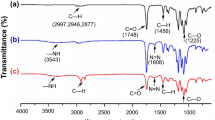Summaries
A series of free radical comb-type acrylic copolymers was prepared in a solution incorporating charged and/or neutral stabilising species on the backbone. The polymer solutions were formulated with cationic biocides to give physically stable formulations with a long shelf life. Furthermore, through the control of polymer architecture of both the side-chain and the backbone, hydrophobicity, a controlled release of a biocide could be achieved. This technology has resulted in the design of temporary coatings demonstrating a sustained surface disinfecting effect. In laboratory trials, coated surfaces with polymeric/biocidal formulations continued to show a disinfection effect after several washes.
Résumé
Une série de copolymères acryliques en peigne à radical libre a été préparée dans une solution qui incorporait sur la chaîne principale des espèces stabilisantes chargées et/ou neutres. Les solutions polymériques étaient formulées en utilisant des biocides cationiques pour donner des formulations qui étaient physiquement stables et qui jouissaient d’une longue durée de conservation avant vente. D’ailleurs, grâce au contrôle de l’architecture polymérique et de la chaîne latérale et de la chaîne principale on pouvait atteindre l’hydrophobicité, une libération contrôlée d’un biocide. Cette technologie a abouti à la conception de revêtements temporaires qui font preuve d’un effet soutenu en ce qui concerne la désinfection de surfaces. Au cours des essais de laboratoire, des surfaces revêtues de formulations polymériques/biocides ont continué à faire preuve d’un effet désinfectant même après plusieurs lavages.
Zusammenfassung
Eine Serie von kammartigen, frei-radikalen Akryl-Kopolymeren wurde in einer Lösung mit geladenen und/oder neutralen Stabilisatoren im Rückgrat hergestellt. Die Polymerlösungen wurden mit kationischen Bioziden hergestellt, die sie lange haltbar machten. Die Hydrophobität sowohl des Polymer-Rückgrades als auch der Nebenketten wurde genau kontolliert, damit das Biozid zielgerecht freigesetzt werden konnte. Diese Technologie hat es uns erlaubt, den Testanstrichen eine nachhaltige Oberflächendisinfektionswirkung zu verleihen. Laborversuche zeigten daß die antimikrobielle Wirkung trotz mehrerer Waschvorgänge verblieb.
Article PDF
Similar content being viewed by others
References
EN 1040 Protocol, European Committee for Standardisation (CEN), Technical Committee 216, ‘Chemical disinfectants and antiseptics’, developed for bactericidal testing
Hawkes N, ‘Touching a door is enough to catch SARS virus’,The Times, 10–21, 5th May 2003
http://www.cdc.gov, Centre for Disease Control (23.04.05)
Oie S, I Hosokawa and A Kamiya, ‘Contamination of room door handles by Methicillin-sensitive/Methicillin-resistantStaphylococcus aureus’,J Hospital Infection,51, 140–3, 2002
Kusumaningrum H D, G. Riboldi, W C Hazeleger and R R Beumer, ‘Survival of food-borne pathogens on stainless steel surfaces and cross-contamination to food’,Int J Food Micro,85, (3), 227–36, 2003
Rusin P, S Maxwell and C Gerba, ‘Comparative surface-to-hand and fingertip-to-mouth transfer of grampositive bacteria, gram-negative bacteria and phage’,J Appl Microbiol,93, 585–92, 2002
http:/www.vantocil.com, PHMB antimicrobial (1.2.05)
Humphries M, J Nemcek, J B Cantwell and J J Gerrand, ‘The use of graft copolymers to inhibit the adhesion of bacteria to solid surfaces’,J FEMS Microbiology Ecology,45, 297–304, 1987
JIS Z 2801, Japanese Industrial Standard, ‘Antimicrobial products: Test for antimicrobial activity and efficacy’, 2000
Author information
Authors and Affiliations
Corresponding author
Rights and permissions
About this article
Cite this article
Gerrard, J.J., Annable, J.A. & Moore, J. The use of comb-type copolymers to sustain the surface bactericidal effect of highly water-soluble cationic biocides. Surface Coatings International Part B: Coatings Transactions 88, 83–91 (2005). https://doi.org/10.1007/BF02699538
Issue Date:
DOI: https://doi.org/10.1007/BF02699538




